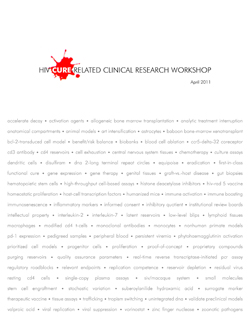A cure for HIV will be an essential part of ending the pandemic.
In the past three years, increasing scientific momentum has been evident in research aimed at curing HIV infection (Lehrman 2005; Richman 2009; Trono 2010; Palmer 2011). The remarkable case of “Berlin Patient” Timothy Brown—an HIV-positive American diagnosed with leukemia who appears to have been cured of HIV infection (Hütter 2009; Allers 2011; Hütter 2011)—has contributed to reinvigorating the scientific community to investigate the possibility of discovering and developing a safe, effective, feasible, and scalable HIV cure (Lewin 2011a, 2011b).
Among the signs of progress, researchers have contributed new insights into where and why HIV persists in the body even when powerful antiretroviral therapy has all but shut it down. Ultrasensitive tests can detect the virus at the level of a single copy of RNA. The first controlled trials of a class of drugs called histone deacetylase (HDAC) inhibitors that may roust HIV from its hiding places are underway, and other types of treatments designed to teach the immune system to either clear or control the virus on its own have been initiated. The National Institutes of Health (NIH) is now funding cure-related research specifically through three consortia funded by grants named after long-time AIDS activist Martin Delaney.
Now that a cure has been proved to be possible, the challenge has moved from encouraging researchers to take up cure-oriented studies to figuring out how to design and conduct those studies. What’s more, given that such trials are likely to confer risks to the HIV-positive people who participate in them, researchers, regulators, and activists must come together to ensure not only that participants are kept safe, but also that research can move forward quickly and confidently, even if the first trials do not produce positive results.
To address these objectives, four HIV research advocacy organizations—the AIDS Policy Project, the Foundation for AIDS Research (amfAR), Project Inform, and the Treatment Action Group (TAG)—convened a meeting in April 2011 bringing together academic researchers, government scientists, regulators, and community advocates to discuss the state of the field and to identify action steps that can be taken to both sustain and hasten the progress of cure-related research.
Some critical questions remain unanswered:
- If HIV eradication is the goal, how can this be proved when the best currently available tests may still miss the tiny residual amount of the virus that can bring the infection roaring back to life when antiretroviral drugs are withdrawn?
- If treatment interruptions are necessary, how can they be conducted safely in research participants when prevailing data suggest that even relatively short treatment interruptions can be harmful for some?
- If immune control of the virus is the objective, what kinds of changes in the immune system and inflammatory markers will tell us we are on the right track? and
- If early trials require participants to take greater risks with little hope of gain, how can we ensure that studies are ethical and guarantee that those taking the risks are fully informed?
The four conference organizers have issued a report laying out the latest thinking on these core questions, the key obstacles in front of us, and a series of next steps proposed by conference attendees to address those challenges.
The work ahead will require new resources and new levels of cooperation and collaboration—among scientists, and among researchers, government agencies, activists, and people with HIV. Workshop cosponsors and participants have all committed to transforming the ideas generated at the conference from words on paper into concrete actions.

